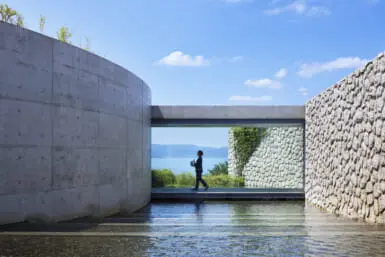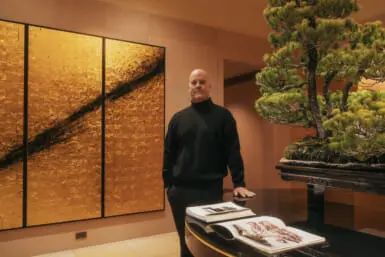Spring in Fukuoka is a vibrant affair, bursting with color as flowers like wisteria, azaleas, peonies and irises put on a beautiful show. From dreamy wisteria tunnels to hillsides covered in gradients of red and pink, here’s your guide to the must-see flower spots that make springtime in Fukuoka so special.

Where To See Wisteria in Fukuoka
Wisteria, or fuji, is a springtime favorite in Japan, and Fukuoka’s offerings are nothing short of breathtaking. The best time to admire them is from late April through early May.
Kawachi Wisteria Garden: Walk Through Tunnels of Wisteria
Kawachi Fujien in Kitakyushu is a private hillside garden famous for its 22 varieties of wisteria that hit their peak bloom between late April and early May. The garden’s main attractions are its two stunning tunnels, both around 100 meters long, where cascading wisteria flowers create a dreamy palette of purples, blues, whites and pinks. Head to the center of the garden and marvel at their large wisteria trellis forming a violet canopy overhead. For a unique perspective, head to the park’s viewpoint, where you can enjoy a panoramic view of the wisteria sprawled out below.
Kurogi no Ofuji: Lounge Beneath Yame City’s Living Legend
While Yame city may be most renowned for its green tea production, it is also home to the Kurogi no Ofuji — an ancient wisteria tree said to be around 630 years old that spreads its majestic branches wide, dripping in purple blossoms. Including its support structures, the total area of the tree covers around 3,000 square meters, and the hanging flower clusters can reach up to 100 centimeters in length. The peak bloom period is early to late April, which also coincides with the Yame Kurogi Wisteria Festival held at Susanoo Shrine, where local food stalls and night illuminations add to the charm.

Where To See Azaleas in Fukuoka
Azaleas, known as tsutsuji in Japan, light up Fukuoka with their striking reds, pinks and purples from late April to early May.
Sarayama Park: Marvel at Azaleas Covering the Hillsides
Nestled at the foot of Mount Wakasugi in Sue town, Sarayama Park transforms into a vibrant canvas in spring, showcasing a breathtaking display of 30,000 azaleas that burst into bloom. This floral spectacle is not just a feast for the eyes: Visit in late April, and you can enjoy the festivities of the Shouko Azalea Matsuri, complete with food stalls and bazaars. Hike to the hilltops, and you might even be able to spot Shikanoshima Island, Hakata Bay and the Itoshima Peninsula from a distance.

Where To See Livingstone Daisies in Fukuoka
Livingstone daisies are known for their vibrant hues and their affinity for sunlight — they close up at nighttime and on cloudy days. In Fukuoka, they bloom from early April to mid-May.
Nokonoshima Island Park: Wander Through a Sea of Daisies
Nokonoshima Island Park, set on a small island located in Hakata Bay near Fukuoka city, is a 10-minute ferry ride from Meinohama Port, followed by a short bus journey. The park is renowned for its seasonal flower displays, and spring brings colorful varieties like nemophila, poppies and tulips. One of the most notable sights is the 30,000 Livingstone daisies that bloom along the slopes from early April to mid-May, creating a spectacular carpet of red, pink, yellow and purple against the backdrop of the cerulean ocean.
Where To See Peonies in Fukuoka
Peonies, or botan, are large, lush flowers associated with beauty and prosperity. Fukuoka’s peony gardens are a feast for the eyes, with thousands of these showy flowers in peak bloom from April to May.
Maizuru Park: See Peonies Pretty In Pink
Right next to the Fukuoka Castle Ruins, you’ll find the peony garden in Maizuru Park, which comes alive in April and May. Some of the standout varieties include the magenta Shima-daijin, the pink Yachiyo-tsubaki and the golden-yellow High Noon. The garden has a rich history, too, as it’s located on the remains of Otaka Yashiki, the home where Fukuoka’s founding father, Kuroda Kanbei, spent his later years.

Where To See Nemophila in Fukuoka
Nemophila — also known as baby blue eyes flowers — are native to North America but grow well in Japan, where they’ve been wholeheartedly embraced for their beauty. When they burst into bloom, from early to late April, they turn the ground into a delicate floral sea.
Uminonakamichi Seaside Park: A Sea of Flowers Set Against Hakata Bay
Uminonakamichi Seaside Park is a sprawling, scenic space located on a peninsula across from Fukuoka city with expansive lawns, beaches and walking paths. It’s known for having a wide variety of plant life, and its beautiful gardens host a plethora of seasonal blooms. April brings a lovely profusion of nemophila, blanketing the ground in vivid blue. When this fantastical floral display overlaps with cherry blossom season, it makes for an extraordinary sight: a vast azure expanse, spread under vibrant pink trees.
Where To See Irises in Fukuoka
Iris flowers, with their slender stems and elegant petals, have long been celebrated in Japanese art and literature. You can find them blooming gracefully from late May to early June.
Yanagawa Tachibana-tei Ohana: Take a Stroll Through Tradition
The iris was considered an auspicious plant by the samurai due to its sword-like leaves and the fact that the Japanese word for the flower — “shoubu” — is a homonym of the word for “military spirit.” As the former residence of the Tachibana clan, the Yanagawa Tachibana-tei Ohana estate features a traditional Japanese garden surrounded by pristine black pines and stone lanterns. Explore the historic grounds and the surrounding museum while enjoying the beauty of the irises, which bloom around the estate’s tranquil pond.

Kojimachi Nadaman Fukuoka Bettei: A Taste of Fukuoka in the Heart of Tokyo
Kojimachi Nadaman Fukuoka Bettei offers an exquisite dining experience in Tokyo, serving traditional Japanese meals crafted from seasonal ingredients straight from Fukuoka Prefecture. The signature Fukuoka Shunsai Kobako course, available year-round, presents a lavish tasting of seasonal dishes, including an appetizer, steamed dish, steamed rice, miso soup and dessert.
“Kobako,” meaning “little box,” refers to the elegant sendan wood container, sourced from Fukuoka, which holds seven small dishes, including sashimi and Hakata wagyu, offering a perfect sampling of ingredients from Fukuoka.
More Info
To make a reservation at Kojimachi Nadaman Fukuoka Bettei, visit their website or call 03-6380-8421.









